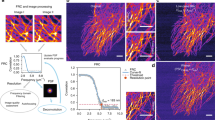Abstract
A method for quantifying and correcting background signals due to back reflections in planar laser-induced fluorescence (PLIF) images is presented. It is shown that reflections of fluorescence off back walls can falsely elevate the signal in a PLIF image. A model for these back reflections is presented, and this model is used to generate a kernel with which images are corrected via direct inverse filtering. The correction method is demonstrated on PLIF images acquired in a static cell: first, background signals are quantified in a static cell by blocking portions of the beam and measuring the fluorescence signal in regions of the image where there is no fluorescence; second, a background correction kernel is generated by recovering the uncontaminated signal via direct inverse filtering. Finally, the method is extended to correct PLIF imaging of supersonic flowfields where large signal gradients exist across a shock wave. The correction is shown to improve agreement between measured expected signal levels on the stagnation line of supersonic flow around a 2D blunt body.











Similar content being viewed by others
References
Agard DA (1984) Optical sectioning microscopy: cellular architecture in three dimensions. Ann Rev Biophys Bioeng 13:191–219
Ayers GR, Dainty JC (1988) Iterative blind deconvolution method and its applications. Opt Lett 13(7):547–549
Boccacci P, Bertero M (1998) Introduction to inverse problems in imaging. Taylor & Francis, London
Campisi P, Egiazarian K (2007) Blind image deconvolution: theory and applications. CRC Press, New York
Cheung B (2011) Trace-based planar laser-induced fluorescence diagnostics: quantitative photophysics and time-resolved imaging. PhD thesis, Stanford University
Clemens NT (2002) Flow imaging. In: Encyclopedia of imaging science and technology. Wiley, New York
Einecke S, Schulz C, Sick V (2000) Measurement of temperature, fuel concentration and equivalence ratio fields using tracer LIF in IC engine combustion. Appl Phys B 71:717–723
Faust S, Dreier T, Schulz C (2011) Temperature and bath gas composition dependence of effective fluorescence lifetimes of toluene excited at 266 nm. Chem Phys 383(1–3):6–11
Heltsley WN, Snyder JA, Houle AJ, Davidson DF, Mungal MG, Hanson RK (2006) Design and characterization of the stanford 6 inch expansion tube. In: 42nd AIAA/ASME/SAE/ASEE joint propulsion conference and exhibit, Sacramento, California, AIAA 2006-4443
Koban W, Koch JD, Hanson RK, Schulz C (2004) Absorption and fluorescence of toluene vapor at eleveated temperatures. Phys Chem Chem Phys 6:2940–2945
Koban W, Koch JD, Sick V, Wermuth N, Hanson RK, Schulz C (2005) Predicting LIF signal strength for toluene and 3-pentanone under engine-related temperature and pressure conditions. In: Proceedings of the combustion institute, vol 30, pp 1545–1553
Kychakoff G, Howe RD, Hanson RK (1984) Quantitative flow visualization technique for measurements in combustion gases. Appl Opt 23(5):704–712
Lozano A, Smith SH, Mungal MG, Hanson RK (1993) Concentration measurements in a transverse jet by planar laser-induced fluorescence of acetone. AIAA J Tech Notes 32(1):218–221
Miller VA, Gamba M, Mungal MG, Hanson RK (2013) Single- and dual-band collection toluene PLIF thermometry in supersonic flows. Exp Fluids 54(6):1–13
Petersen B, Ghandhi J, Koch J (2008) Fluorescence saturation measurements of 3-pentanone. Appl Phys B 93:639–644
Roddier F (1981) The effects of atmospheric turbulence in optical astronomy. Prog Optics 19:281–376
Schardin H (1942) Die schlierenverfahren und ihre anwendungen. Ergebnisse der Exakten Naturwissenschaften 20:303–439
Settles GS (2001) Schlieren and shadowgraph techniques. Springer, New York
Worden SP, Lynds CR, Harvey JW (1976) Reconstructed images of Alpha Orionis using stellar speckle interferometry. J Opt Soc Am 66(11):1243–1246
Yoo J (2011) Strategies for planar laser-induced fluorescence thermometry in shock tube flows. PhD thesis, Stanford University
Acknowledgments
This paper is based upon work supported by the Air Force Office of Scientific Research (AFOSR) and by the Department of Energy under the Predictive Science Academic Alliance Program (PSAAP) at Stanford University, award number DE-FC52-08NA28614. V. A. Miller is supported by the Claudia and William Coleman Foundation Stanford Graduate Fellowship. The author would also like to thank M Gamba, MG Mungal, and RK Hanson for their guidance.
Author information
Authors and Affiliations
Corresponding author
Rights and permissions
About this article
Cite this article
Miller, V.A. Quantifying and correcting for contamination of PLIF images due to background signals. Exp Fluids 54, 1566 (2013). https://doi.org/10.1007/s00348-013-1566-7
Received:
Revised:
Accepted:
Published:
DOI: https://doi.org/10.1007/s00348-013-1566-7




